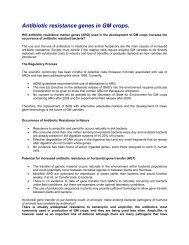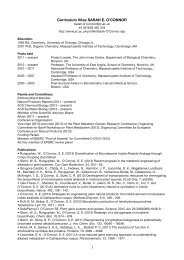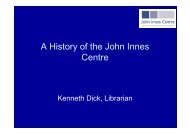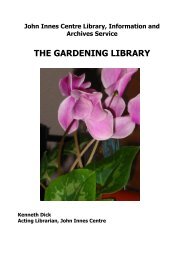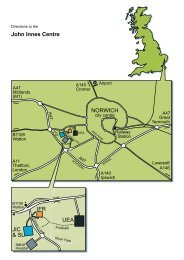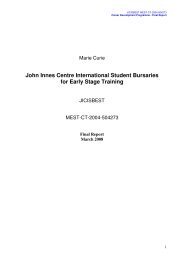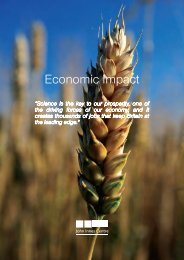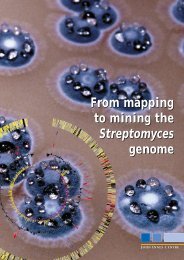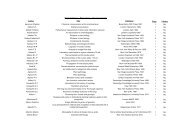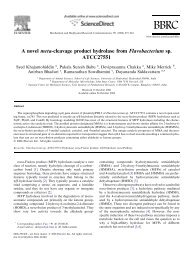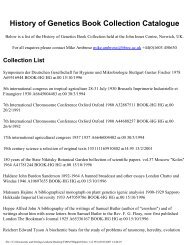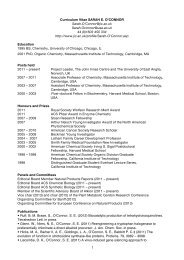Detailed Contents of "Practical Streptomyces Genetics" - John Innes ...
Detailed Contents of "Practical Streptomyces Genetics" - John Innes ...
Detailed Contents of "Practical Streptomyces Genetics" - John Innes ...
Create successful ePaper yourself
Turn your PDF publications into a flip-book with our unique Google optimized e-Paper software.
The S. coelicolor antibiotics................. 93<br />
Actinorhodin ......................... 93<br />
Undecylprodigiosin ................... 95<br />
CDA ............................... 95<br />
Methylenomycin...................... 95<br />
S. lividans as an antibiotic producer........... 95<br />
Secondary metabolite production in S. lividans<br />
transformants .................. 95<br />
Chapter 5 Mutagenesis <strong>of</strong> <strong>Streptomyces</strong> by<br />
irradiation or chemicals<br />
General remarks about mutagenesis ............... 99<br />
The optimal amount <strong>of</strong> mutagenesis ........... 99<br />
Expression <strong>of</strong> mutations ................... 100<br />
Spores or mycelium? ..................... 101<br />
Choice <strong>of</strong> mutagen ....................... 101<br />
Precautions ............................. 101<br />
Mutagenesis <strong>of</strong> <strong>Streptomyces</strong> spores by ultraviolet<br />
light (UV) ....................... 102<br />
Mutagenesis <strong>of</strong> <strong>Streptomyces</strong> spores by N-methyl-Nnitro-N-nitrosoguanidine<br />
(NTG) ...... 103<br />
Isolation <strong>of</strong> specific classes <strong>of</strong> mutant ............ 104<br />
Resistant mutants ........................ 104<br />
Mutants that have to be isolated by screening . . 104<br />
Auxotrophs ......................... 104<br />
Other classes <strong>of</strong> mutants screened by replica<br />
plating......................... 106<br />
Mutants recognised by visual examination . 106<br />
Chapter 6 Transposon mutagenesis in <strong>Streptomyces</strong><br />
General points about transposon mutagenesis ...... 109<br />
Discovery <strong>of</strong> <strong>Streptomyces</strong> transposable elements 110<br />
<strong>Streptomyces</strong> transposons suitable for<br />
mutagenesis <strong>of</strong> <strong>Streptomyces</strong> ........ 110<br />
Use <strong>of</strong> heterologous transposons for<br />
mutagenising <strong>Streptomyces</strong> genes..... 110<br />
Transposon delivery vectors for <strong>Streptomyces</strong> . . 110<br />
Isolation <strong>of</strong> independent mutant strains ....... 111<br />
Cloning transposon-tagged <strong>Streptomyces</strong><br />
DNA in E. coli ................... 111<br />
Tn4556 from S. fradiae ....................... 111<br />
A. Transposition <strong>of</strong> Tn4560 from pUC1169 to a<br />
chromosomal location.............. 112<br />
B. Protocol for inserting Tn4560 into<br />
S. coelicolor NF strains ............ 113<br />
C. Tn4560 mutagenesis <strong>of</strong> SCP2* plasmids in<br />
S. lividans ....................... 114<br />
D. Tn4560 mutagenesis <strong>of</strong> pock-forming SCP2*<br />
in S. coelicolor ................... 115<br />
IS493 from S. lividans 66 ...................... 117<br />
E. Sectoring method for delivering IS493<br />
derivatives using temperature-sensitive<br />
plasmids ........................ 117<br />
IS6100 from Mycobacterium fortuitum ........... 119<br />
F. Transposon mutagenesis <strong>of</strong> S. lividans using<br />
pSIT151 ........................ 119<br />
Tn5493 derived from Tn5 ..................... 121<br />
G. Mutagenising S. lividans using pJOE2577 . . 121<br />
H. Alternative method for isolating S. lividans<br />
with random insertions <strong>of</strong> Tn5493 .... 122<br />
Chapter 7 In vivo genetic analysis by conjugation<br />
and protoplast fusion<br />
The modes <strong>of</strong> gene exchange in <strong>Streptomyces</strong> ...... 125<br />
Mating ................................ 125<br />
Protoplast fusion......................... 128<br />
Transduction............................ 128<br />
Chromosomal recombination by transformation 128<br />
Electroporation .......................... 130<br />
The practicalities <strong>of</strong> making crosses .............. 130<br />
Quantitative analysis <strong>of</strong> crosses ................. 136<br />
Recombination frequency.................. 136<br />
Frequency <strong>of</strong> plasmid transfer .............. 137<br />
Linkage mapping ........................ 137<br />
Establishing a genetic map by the "four-on-four"<br />
procedure ........................... 141<br />
The "classical" way <strong>of</strong> analysing the results <strong>of</strong> a<br />
"four-on-four" cross .................. 144<br />
Analysing the results <strong>of</strong> a "four-on-four" cross by<br />
minimizing multiple crossovers ......... 147<br />
Mapping a new marker by a single selection ....... 147<br />
Plate-crosses................................ 152<br />
Detection <strong>of</strong> conjugative plasmids by "pock"<br />
formation by transconjugants ............ 153<br />
Protoplast fusion ............................ 156<br />
Fusion <strong>of</strong> protoplasts <strong>of</strong> S. coelicolor<br />
or S. lividans ........................ 157<br />
Genetic analysis by protoplast fusion ......... 158<br />
Chapter 8 Preparation and analysis <strong>of</strong> genomic and<br />
plasmid DNA<br />
Isolation <strong>of</strong> genomic DNA ..................... 162<br />
Discussion <strong>of</strong> individual steps .............. 162<br />
A. Kirby mix procedure for the isolation <strong>of</strong><br />
genomic DNA ...................... 168<br />
B. Salting out procedure for the isolation <strong>of</strong><br />
genomic DNA....................... 169<br />
C. CTAB procedure for the isolation <strong>of</strong> genomic<br />
DNA .............................. 170<br />
Isolation <strong>of</strong> CCC plasmid DNA ................. 171<br />
Discussion <strong>of</strong> individual steps .............. 172<br />
A. Plasmid isolation by neutral lysis ......... 177<br />
B. Standard CsCl-ethidium bromide gradient<br />
centrifugation ....................... 178<br />
C. CsCl density gradient for removing<br />
polysaccharides from DNA ............. 182<br />
D. Plasmid isolation by alkaline lysis and<br />
potassium acetate precipitation .......... 184<br />
E. Plasmid isolation by alkaline lysis and phenol



